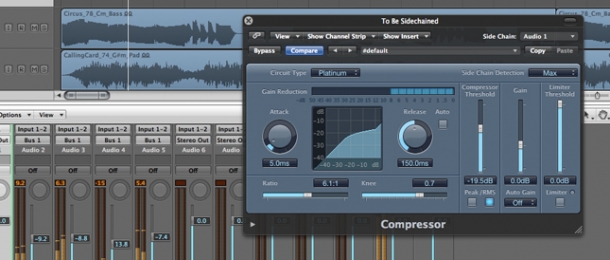

Then we start working up that release time until we get the pump in the correct rhythm that we want for the rest of our song. The way we do that is to take the threshold right down to 0, take the attack down as fast as it will go and put the ratio right up. Now the tick from this side chain track is going to compress the bassline. Now open up a compressor on the track you want to sidechain compress (e.g the bass line), then route your sidechain trigger audio into the sidechain input on the compressor.


Route the audio to “sends only” so you can't actually hear the drum playing, but the audio is still being sent through the system so we can access it through the send controls. Usually it would be a 4/4 beat but if you're doing a future bass track you'd usually program in your sidechain triggers to hit at the same time as your kicks play. Program in the pattern of the sidechain trigger that you want. I use a rimshot sound, actually, so all of the sustain and release is done with the controls of the compressor). Sidechain Technique 1: Dedicated Sidechain Trigger TrackĬreate a new MIDI channel with a sampler, and load in a drum sample (I prefer a very short, sharp tick. If you want to know how a compressor works, check this post out. NOTE: There are actually some advanced professor sidechain compression techniques to play with, too, but they’re a bit beyond the scope of this post. Not many people know, though, but there are four different ways that you can achieve this effect (video of each at the end of this post): It can be used as an extreme creative effect, or as a subtle tool. It can help glue your kick and bass together.Ĥ. It can help your kick drum really punch through the mix.ģ. Here are some of the reasons it's such a useful technique:ġ. One of the first tracks that really brought it to the attention of a lot of producers was Eric Prydz’ “Call on Me”, with the strings being “ducked” by the kick drum, giving it a pumping feel (check it out below): Sidechain compression used to be nigh-on impossible, but with the advent of powerful plugins, pretty much EVERY compressor plugin now has this feature. It was truly one of those “Eureka!” moments (except I wasn’t sat in a bath at the time, of course. For me, one of them was definitely getting to grips with sidechain compression. Sidechain compression is a technique that’s found its way into pretty much EVERY dance track in the world – in all genres – and for VERY good reason.įrom time to time, you learn something that helps your reach a new level of production quality. Learning how to sidechain properly is a production technique that can just up the quality of all your tracks, and in this post, we walk through four techniques to achieve similar results.


 0 kommentar(er)
0 kommentar(er)
